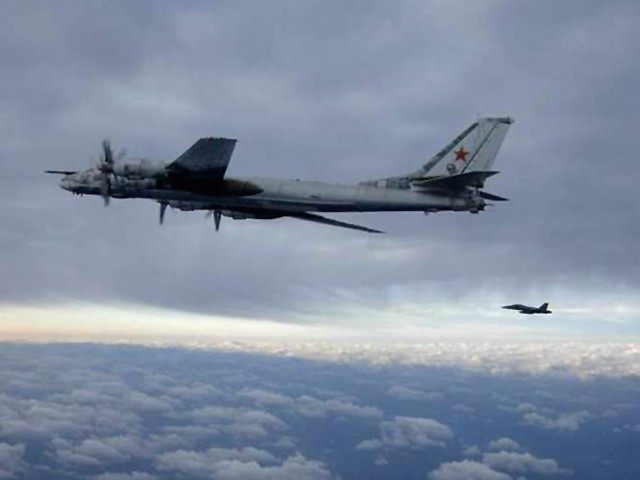On July 4, Two Russian Tu-95 Bear Bombers, which can carry nuclear warheads, flew within 40 miles of the Northern California Coast around the time Russia’s President Putin and America’s President Obama conducted a private telephone call that the Kremlin referred to as an effort to “find solutions” to international issues.
F-15 fighters were scrambled to intercept the bombers, which are capable of launching six KH-555 Air Launched Cruise Missiles with nuclear or conventional warheads at a speed of 1,000 miles per hour and a range of around 1,500 miles. The incursion “incident” was the closest buzz of the West Coast of California since the Cold War.
As the interceptors roared into contact just north of San Francisco, one of the Russian crew members made a statement in what was described by military sources as a threatening tone on an emergency channel: “Good morning American pilots, we are here to greet you on your Fourth of July Independence Day.”
The Colorado based U.S. Northern Command, which guards North American airspace, regularly intercepted TU-95 Bear Bombers that would penetrate the restricted 12 to 24 nautical mile U.S. Contiguous Zone to provocatively skirt the banned U.S. 12-mile Air Defense Identification Zone by scrambling warplanes from Elmendorf Air Force Base near Anchorage.
But other than a few “incidents” in 2008, there had been virtually no provocative actions by Russian bombers until the spring of 2014, when the U.S. began an effort to rally its allies to put sanctions on Russia over the dispute in the Ukraine.
Breitbart News reported that on May 5, 2014, Air Force General Herbert J. Carlisle disclosed at a Washington DC think tank meeting there had been a number of Russian long-range single-aircraft patrols off the California Coast and a circumnavigation of the U.S. Pacific territory of Guam. A month later, four Russian bombers flew within 50 miles of the California Coast.
But in a much more serious incident in September 2014, the Northern Command scrambled multiple pairs of F-15s and F-22 Raptor fighters from Elmendorf to intercept what appeared to be a Russian attack squadron. The six-plane group included two long-range Bear Bombers, two refueling tankers and two Mikoyan MiG-31 fighters. The formation aggressively penetrated the U.S. Air Defense Identification Zone (ADIZ) off the Alaskan coast, according to the Washington Times.
A pair of Tu-95 Bear H bombers was also reported on April 22 of this year to have flown into the US AIDZ off of Alaska’s coast. But U.S. military officials downplayed the Russian fly-by as just the beginning of their long-range aviation spring training cycle, and commented that American fighter jets were not dispatched to make interceptions.
The Russian intrusion on the Fourth of July off of California would be the first provocation of its kind in U.S. or Canadian ADIZs this year. Some military analysts see the bomber flights as mere saber-rattling by Moscow, which has recently raised international tensions with a steady stream of anti-U.S. rhetoric.
But a new National Institute study entitled “Foreign Nuclear Developments: A Gathering Storm,” warns that, “While many in the West believe that the end of the Cold War has meant the end of a confrontational and adversarial relationship with Russia, recent events suggest this hoped-for outcome is more the result of wishful thinking than of a sober and realistic assessment of the current geostrategic environment.”
The National Institute suggests that Russia’s across-the-board buildup of nuclear forces and revised first-strike-doctrine are increasing the danger of a nuclear war.

COMMENTS
Please let us know if you're having issues with commenting.